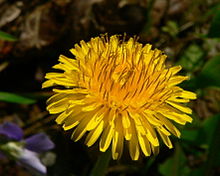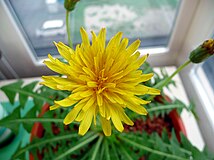Taraxacum
From Wikipedia, the free encyclopedia
 |
| A dandelion flower head composed of hundreds of smaller florets |
| Scientific classification | |
|---|---|
| Kingdom: | Plantae |
| (unranked): | Angiosperms |
| (unranked): | Eudicots |
| (unranked): | Asterids |
| Order: | Asterales |
| Family: | Asteraceae |
| Tribe: | Cichorieae |
| Genus: | Taraxacum F. H. Wigg. |
| Type species | |
| Taraxacum officinale F. H. Wigg. | |
 |
| A dandelion flower seed head |
Taraxacum /təˈræksəkʉm/ is a large genus of flowering plants in the family Asteraceae. They are native to Eurasia and North and South America, and two species, T. officinale and T. erythrospermum, are found as weeds worldwide. Both species are edible in their entirety. The common name dandelion (/ˈdændɨlaɪ.ən/ DAN-di-ly-ən, from French dent-de-lion, meaning "lion's tooth") is given to members of the genus and, like other members of the Asteraceae family, they have very small flowers collected together into a composite flower head. Each single flower in a head is called a floret. Many Taraxacum species produce seeds asexually by apomixis, where the seeds are produced without pollination, resulting in offspring that are genetically identical to the parent plant.
Description
The species of Taraxacum are tap-rooted biennial or perennial herbaceous plants, native to temperate areas of the Old and New Worlds.The leaves are 5–25 cm long or longer, simple and basal, entire or lobed, forming a rosette above the central taproot. The flower heads are yellow to orange coloured, and are open in the daytime but closed at night. The heads are borne singly on a hollow stem (scape) that rises 1–10 cm or more above the leaves and exudes a milky latex when broken. A rosette may produce several flowering stems at a time. The flower heads are 2–5 cm in diameter and consist entirely of ray florets. The flower heads mature into spherical seed heads called "blowballs" or "clocks" (in both British and American English) containing many single-seeded fruits called achenes. Each achene is attached to a pappus of fine hairs, which enable wind-aided dispersal over long distances.
The flower head is surrounded by bracts (sometimes mistakenly called sepals) in two series. The inner bracts are erect until the seeds mature, then flex downward to allow the seeds to disperse; the outer bracts are always reflexed downward. Some species drop the "parachute" from the achenes; the hair-like parachutes are called pappus, and they are modified sepals. Between the pappus and the achene, there is a stalk called a beak, which elongates as the fruit matures. The beak breaks off from the achene quite easily, separating the seed from the parachute.
Seed dispersal
| Segment of pappus fiber showing barbs. |
A number of species of Taraxacum are seed dispersed ruderals that rapidly colonize disturbed soil, especially the common dandelion (T. officinale), which has been introduced over much of the temperate world. After flowering is finished, the dandelion flower head dries out for a day or two. The dried petals and stamens drop off, the bracts reflex (curve backwards), and the parachute ball opens into a full sphere.
False dandelions
 |
| Hawksbeard flower heads and ripe seeds are sometimes confused with dandelions. |
Many similar plants in the Asteraceae family with yellow flowers are sometimes known as "false dandelions". Dandelions are very similar to catsears (Hypochaeris). Both plants carry similar flowers, which form into windborne seeds. However, dandelion flowers are borne singly on unbranched, hairless and leafless, hollow stems, while catsear flowering stems are branched, solid and carry bracts. Both plants have a basal rosette of leaves and a central taproot. However, the leaves of dandelions are smooth or glabrous, whereas those of catsears are coarsely hairy.
Other plants with superficially similar flowers include hawkweeds (Hieracium) and hawksbeards (Crepis). These are readily distinguished by branched flowering stems, which are usually hairy and bear leaves.
Classification
The genus is taxonomically complex, with some botanists dividing the group into about 34 macrospecies, and about 2000 microspecies; approximately 235 apomictic and polyploid microspecies have been recorded in Great Britain and Ireland. Some botanists take a much narrower view and only accept a total of about 60 species.Selected species
- Taraxacum albidum, a white-flowering Japanese dandelion.
- Taraxacum aphrogenes, Paphos dandelion
- Taraxacum brevicorniculatum, frequently mis-identified as Taraxacum kok-saghyz, and a poor rubber producer
- Taraxacum californicum, the endangered California dandelion
- Taraxacum centrasiaticum, the Xinjiang dandelion
- Taraxacum holmboei, Troödos dandelion
- Taraxacum platycarpum, the Korean dandelion
- Taraxacum japonicum, Japanese dandelion. No ring of smallish, downward-turned leaves under the flowerhead.
- Taraxacum kok-saghyz, Russian dandelion, which produces rubber
- Taraxacum laevigatum, Red-seeded dandelion; achenes reddish brown and leaves deeply cut throughout length. Inner bracts' tips are hooded.
- Taraxacum erythrospermum, often considered a variety of Taraxacum laevigatum.
- Taraxacum officinale (syn. T. officinale subsp. vulgare), common dandelion. Found in many forms.
- Taraxacum ceratophorum, Northern dandelion
T. albidum
|
T. californicum
|
T. japonicum
|
T. laevigatum
|
T. officinale
|
T. platycarpum
|
Cultivars
- 'Amélioré à Coeur Plein' - Yields an abundant crop without taking up much ground, and tends to blanch itself naturally, due to its clumping growth habit.
- 'Broad Leaved' - The leaves are thick and tender and easily blanched. In rich soils they can be up to 60 cm wide. Plants do not go to seed as quickly as French types.
- 'Vert de Montmagny'- Long dark green leaves, some find them mild enough to be palatable without blanching. Vigorous and productive.
History
Dandelions are thought to have evolved about thirty million years ago in Eurasia. They have been used by humans for food and as a herb for much of recorded history.Names
 |
| Leaf resemblance to lion tooth |
The English name, dandelion, is a corruption of the French dent de lion meaning "lion's tooth", referring to the coarsely toothed leaves. The plant is also known as blowball, cankerwort, doon-head-clock, witch's gowan, milk witch, lion's-tooth, yellow-gowan, Irish daisy, monks-head, priest's-crown and puff-ball; other common names include faceclock, pee-a-bed, wet-a-bed, swine's snout, white endive, and wild endive.
"The English folk name for the plant "piss-a-bed" refers to the strong diuretic effect of the plant's roots. In various north-eastern Italian dialects, the plant is known as pisacan ("dog pisses"), because they are found at the side of pavements.
In Swedish, it is called maskros ('worm rose') after the small insects (thrips) usually present in the flowers. In Finnish and Estonian the names (voikukka, võilill) translate as 'butter flower', due to the color of the flower.
Properties
Edibility
Dandelions are found on all continents and have been gathered for food since prehistory, but the varieties cultivated for consumption are mainly native to Eurasia. A perennial plant, its leaves will grow back if the taproot is left intact. To make leaves more palatable, they are often blanched to remove bitterness. or sauteed in the same way as spinach. Dandelion leaves and buds have been a part of traditional Sephardic, Chinese, and Korean cuisine. In Crete, Greece, the leaves of a variety called Mari (Μαρί), Mariaki (Μαριάκι) or Koproradiko (Κοπροράδικο) are eaten by locals, either raw or boiled, in salads. Taraxacum megalorhizon, a species endemic to Crete, is eaten in the same way; it is found only at high altitudes (1000 to 1600 m.) and in fallow sites, and is called pentaramia (πενταράμια) or agrioradiko (αγριοράδικο).The flower petals, along with other ingredients, usually including citrus, are used to make dandelion wine. The ground, roasted roots can be used as a caffeine-free dandelion coffee. Dandelion was also traditionally used to make the traditional British soft drink dandelion and burdock, and is one of the ingredients of root beer. Also, dandelions were once delicacies eaten by the Victorian gentry, mostly in salads and sandwiches.
Dandelion leaves contain abundant vitamins and minerals, especially vitamins A, C and K, and are good sources of calcium, potassium, iron and manganese.
Medicinal uses
Main article: Medicinal properties of dandelion
Historically, dandelion was prized for a variety of medicinal
properties, and it contains a wide number of pharmacologically active
compounds. Dandelion is used as a herbal remedy in Europe, North America and China. It has been used in herbal medicine to treat infections, bile and liver problems, and as a diuretic.Food for wildlife
Taraxacum seeds are an important food source for certain birds.Dandelions are also important plants for northern hemisphere bees, providing an important source of nectar and pollen early in the season. Dandelions are used as food plants by the larvae of some species of Lepidoptera (butterflies and moths). See List of Lepidoptera that feed on dandelions. They are also used as a source of nectar by the pearl-bordered fritillary (Boloria euphrosyne), one of the earliest emerging butterflies in the spring.
Benefits to gardeners
The dandelion plant is a beneficial weed, with a wide range of uses, and is even a good companion plant for gardening. Its taproot will bring up nutrients for shallower-rooting plants, and add minerals and nitrogen to soil. It is also known to attract pollinating insects and release ethylene gas which helps fruit to ripen.Cultural importance
Four dandelion flowers are the emblem of White Sulphur Springs, West Virginia. The citizens celebrate spring with an annual Dandelion Festival.The dandelion is the official flower of the University of Rochester and "Dandelion Yellow" is one of the school's official colors. The Dandelion Yellow is an official University of Rochester song.






Tidak ada komentar:
Posting Komentar